How do you coordinate lighting in an open floor plan? 5 rules design experts live by
If you're wondering how to coordinate lighting in an open floor plan, we have all the pointers and tips for you
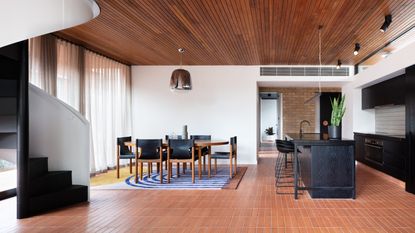

How to coordinate lighting in an open floor plan can be a tricky one. From recessed to overhead, task to accent, there are so many ways to light a large space, and when working with an open floor plan, there are different areas to consider as well as how the whole scheme comes together. It's a real balancing act and it's imperative you get it right. A badly lit space can leave an open plan space feeling drafty and cold.
'Open plan spaces are usually seen as harder to illuminate in terms of consistency and balance but actually, I think they are the most interesting and fun,' says Noor Charchafchi, founder & CEO of Celine Interior Design. 'There’s so much more space to play with and lighting can be used as a great way to section different areas or zones or act as a subtle tool to pull the eye and create focal points.'
To get it right, we've spoken to the lighting experts who have some useful tips for open plan living room lighting ideas, and more, so your scheme is beautiful and cohesive in every way.

Oonagh is an experienced homes writer and interiors editor. For this piece, she spoke to various architects and designers to get their top tips on how to beautifully light an open plan space.
How do you coordinate lighting in an open floor plan?
When designing your lighting in an open plan scheme, it's all about zoning the space, and an open floor plan typically has different zones with different functions and moods. 'It's about how the individual zones are used at any one time,' explains Richard Gill of Richard Gill Architects. 'This may lead to conflicting lighting requirements across the zones. The important point to note is that it should not be intended that all circuits will be switched on at the same time. Dimming is also important to allow scene setting.'
An open plan scheme is all about layering your lighting and mixing up the light sources. Avoid keeping all lights the same and mix and match so the lighting appears more collected. Read on for our five rules to live by when lighting open-plan settings.
1. Build a foundation with recessed lighting

In some ways, recessed lighting is your base for a beautifully lit open-plan space, and from here, you can build a comprehensive lighting scheme.
'With an open floor plan, creating layers of light is key,' explains Jennifer J. Morris, interior design and principal at J Morris. 'Some clients have real aversions to recessed lights because of the hot spots they create and the glare, but I find being able to wash the walls in light with soffit or recessed light a necessary foundational layer. It could be the dead of winter or the rainiest day but if the walls glow with light, it can make a big difference.'
When laying out recessed lighting, you want the fixtures to be equally spaced apart; not too close together or they'll dazzle anyone who happens to glance up. Space them evenly around the room making sure that the beam spread of each light overlaps. You also want to avoid placing your recessed lights in rows, as this can look rigid and structured when you want the look to be more patterned.
To get the spacing spot on, a good rule of thumb to follow is that the distance apart is dictated by the size. A 4-inch recessed light fixture should be placed around 4 feet apart, while a 6-inch recessed light should be placed around 6 feet apart.
Timothy Archambault, the director of the Americas at Oppenheim Architecture, says that recessed lights need a dimmer. 'Recessed lighting in conjunction with floor or desk mounted task lighting is a good option as long as all are controlled by separate dimming systems to achieve appropriate lighting levels and balance,' he says.
2. Or try track lights

Track lighting can also provide a good base in an open-plan set-up and can give a Mid-Century, stylish vibe. Lights are fitted on tracks, and each light can be twisted to face a specific direction. 'I like streamlining the lighting to a tracked look. Track lighting has taken big steps to look more attractive,' says Jennifer.
Track lights, like recessed lights, help to break up your open plan space and create a grid-type room. 'A grid of floor and ceiling fixtures or recessed tracks help to zone the space,' says Timothy. They work well as kitchen lighting, sectioning off an open plan scheme – zoning the space, offering plenty of light to a busy space where there needs to be a lot of light, and giving the air of a professional kitchen.
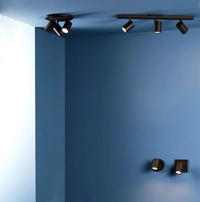
Ascoli Track Light from Lumens
Perfect for zoning the space, these track lights are subtle but stylish in jet black, and can be rotated to give light in the areas that need it.
3. Don't forget overhead lighting
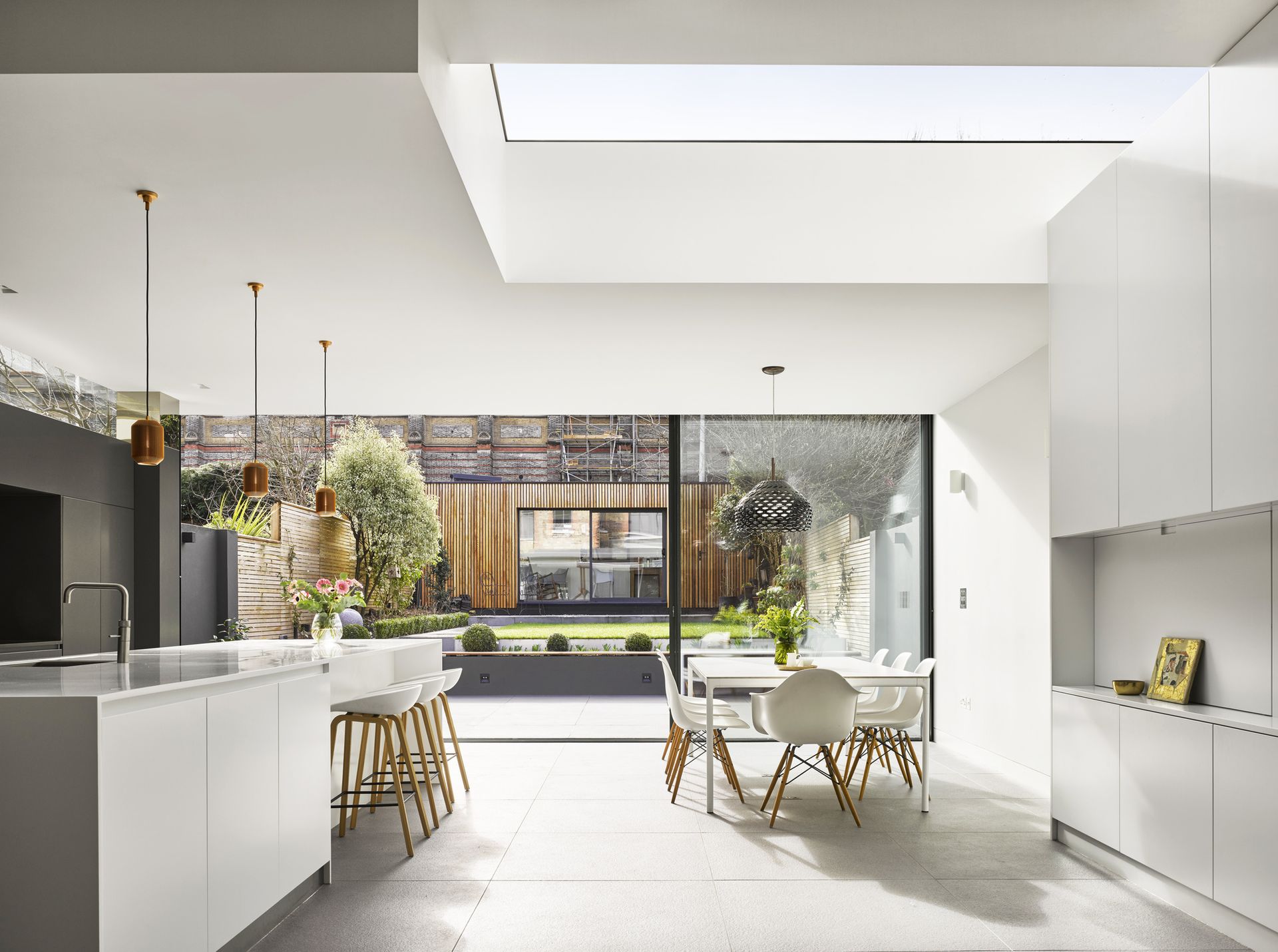
Once you have figured out the foundational lighting in your open plan space, it's now time to think about adding to the scheme with overhead lighting. This is the next layer of lighting and requires specific attention in an open-plan space to help create those zones.
A statement light fixture is an epic way to do zone the space, says interior designer Gina Holz. 'A chandelier over a dining table or coffee table can help ground the space and create an environment within a large area.'
This example from architect Richard Gill shows overhead lighting taking the lead in an open-plan space. 'For Dukes House, the open plan space has been planned around kitchen, dining, and living,' says Richard. 'Each space needs to work independently, whilst complementing its neighbor. After architectural recessed lights, background wall lights, and task lighting, we thought about the feature lighting. Here pendants have been used in each zone to add warmth and character, maybe a sense of playfulness.'
Remember to have a couple dotted, but not too many to avoid fixing furniture in permanent locations. It's about getting the balance right between the different spaces. 'I love statement lights but in an open floor plan, I feel they can lock the furniture to centers and locations and feel crowded if you have a few locations,' says Jennifer. Avoid this by picking two key locations for your overhead lighting and keeping things uneven in numbers. In an open floor plan, you might want three pendants over a kitchen island and one statement light fixture over a dining table or living area.
Remember that different zones with different overhead lighting features will want different controls and both want light switch dimmers so you can fully take charge of what zone is in use and when.
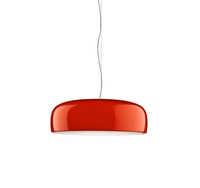
Smithfield Suspension from Flos
A bright red pop of aluminium, great for a statement dining table light fixture or one of three hanging over a kitchen island.
4. Add task lighting to cozy corners

Task lighting is another important layer that is needed in an open plan space, helping to create a different mood in a part of the open plan space when walls don't exist to zone the space. You might have a busy, light-filled kitchen that is a hive of activity, but if you want to create a cozier feel in another part of the open-plan space that is more about relaxation, task lights can help.
In many ways, this part of lighting comes last in coordinating your lighting in your open floor plan. 'I would rely on floor and table lamps to do the heavy lifting of the task, but also give the softer glow that ceiling lights can’t provide,' says Jennifer. A narrow space or dark corner that needs more excitement may call for a floor lamp, whereas a larger nook with side table space works with a table lamp.
In this scheme from Modscape, track lighting is supplemented with a floor light that provides lighting in a seating area. The light is focused and adds a decorative detail to the room.
'Wall sconces can be a great tool for task lighting too,' advises Jennifer. 'Make sure to keep wall sconces at face level. Lighting at face level is always more attractive. So in a dining room at a dinner party, everyone will look great with dimmed wall sconce light.'
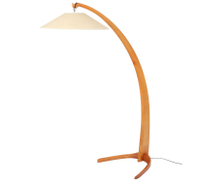
Italian Curved Beech Arc Floor Lamp from 1st Dibs
It's a bit on the pricey side, but this design mid-century style overreach lamp sure would make a statement in your open plan room, in curved beech with a two prong base and parchment shade.
5. Pay attention to how much light a bulb gives off

An open-plan space serves various functions and purposes, so paying attention to the number of bulbs, wattage, and visibility of bulbs will help you understand the amount of light a fixture gives off. This can allow you to choose appropriately for your space.
'Put hardwired light fixtures on dimmers and also pay attention to the wattage (for incandescent) or lumen output (for LED) in lamps that may not have a dimming feature, which is most lamps,' advises Janelle Burns, interior designer at Maestri Studio.
'You do not need anything higher than 60 watt equivalent in lamps it's best to use 25 and 40-watt equivalent in lamps so a small space isn't uncomfortably bright (40 watts for a single lamp, 25 in the case of lamp pairs),' says Janelle.
'This living space has a high ceiling and a dramatic fluted plaster fireplace wall, so we opted for an MCM-style chandelier on a dimmer at the ceiling, then down at the furniture level there is softer ambient light from floor lamps flanking the sofa sectional, and a reading task lamp tucked in by the lounger,' says Janelle. 'The lighting options make the smaller footprint of this room feel cozy, despite the tall ceiling.'
For task lighting or any mood lighting, Gina finds that you must choose a warm light bulb and forgo fluorescent or bright white bulbs. 'If you are using LED bulbs I like 2700K. Otherwise, a soft halogen bulb is effective and casts a warm hue.'
How do you choose a timeless light fixture?
Lighting is an investment, so your choice must stand the test of time. When picking statement lighting, modern designs can often be obscure or have a distinctive design that anchors it to a trend that might well very quickly change.
Firstly think about how decorative your given room is. A statement light can add a busy, cluttered feel to a room that is already heavily decorated, so unless you want to go ahead with this maximalist style, this might help you decide how decorative you want your statement light to be.
Also really consider the type of chandelier. A chandelier can look quite ornate and often is so classical that it is timeless, but equally, a modern style of the old-fashioned chandelier can quickly look like an old trend. If you're worried that your light fixture might not stand the test of time, it's best to go simple. A pendant in a simple, muted color won't go out of fashion.
Also, think about investing in a fixture that can be flexible and can get easily changed around if you're someone who might grow bored quickly. Go for a simple table lamp base and mix and match the lampshade. You also ultimately want to invest in good quality. Solid metal won't easily cheapen, or aluminum.
Be The First To Know
The Livingetc newsletter is your shortcut to the now and the next in home design. Subscribe today to receive a stunning free 200-page book of the best homes from around the world.

Oonagh is a content editor at Livingetc.com and an expert at spotting the interior trends that are making waves in the design world. Writing a mix of everything and everything from home tours to news, long-form features to design idea pieces on the website, as well as frequently featured in the monthly print magazine, she's the go-to for design advice in the home. Previously, she worked on a London property title, producing long-read interiors features, style pages and conducting interviews with a range of famous faces from the UK interiors scene, from Kit Kemp to Robert Kime. In doing so, she has developed a keen interest in London's historical architecture and the city's distinct tastemakers paving the way in the world of interiors.
-
 How to Thaw a Frozen Pipe — Learn Everything You Need to Know in 5 Minutes With This Guide
How to Thaw a Frozen Pipe — Learn Everything You Need to Know in 5 Minutes With This GuideWinter storm caught you off guard? We asked an expert — just how do you thaw a frozen pipe?
By Hugh Metcalf Published
-
 The 12 Very Best Silk Bedding Pieces — As Our Style Editor Says: 'It's What Dreams Are Made Of!'
The 12 Very Best Silk Bedding Pieces — As Our Style Editor Says: 'It's What Dreams Are Made Of!'Slumber in lustrous luxury with the very best silk bedding sheets, duvets, pillowcases, and more — your sleep score will thank us later
By Julia Demer Published

